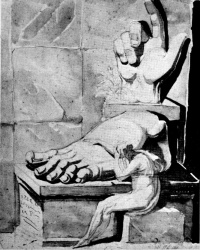Thoughts on the Imitation of Greek Works in Painting and Sculpture
From The Art and Popular Culture Encyclopedia
| Revision as of 17:34, 7 March 2013 Jahsonic (Talk | contribs) ← Previous diff |
Revision as of 17:34, 7 March 2013 Jahsonic (Talk | contribs) Next diff → |
||
| Line 1: | Line 1: | ||
| + | [[Image:The Artist Moved by the Grandeur of Ancient Ruins.jpg|thumb|right|200px| | ||
| + | ''[[The artist's despair before the grandeur of ancient ruins]]'' ([[1778]]-[[1779|79]]) by [[Fuseli|Henry Fuseli]]]] | ||
| {{Template}} | {{Template}} | ||
| :''"[[The only way for us to become great lies in the imitation of the Greeks]]"'' | :''"[[The only way for us to become great lies in the imitation of the Greeks]]"'' | ||
Revision as of 17:34, 7 March 2013
|
Related e |
|
Featured: |
Thoughts on the Imitation of Greek Works in Painting and Sculpture (Original German: Gedanken über die Nachahmung der griechischen Werke in Malerei und Bildhauerkunst) is an essay by German art critic Johann Joachim Winckelmann published in 1755. It is a manifesto of sorts of Neoclassicism. The work included a feigned attack on the work and a defense of its principles, ostensibly by an impartial critic. The Gedanken contains the first statement of the doctrines he afterwards developed, the ideal of "noble simplicity and quiet grandeur" (edle Einfalt und stille Größe) and the definitive assertion, "The one way for us to become great, perhaps inimitable, is by imitating the ancients." The work was warmly admired not only for the ideas it contained, but for its literary style. It made Winckelmann famous, and was reprinted several times and soon translated into French. In England, Winckelmann's views stirred discussion in the 1760s and 1770s, although it was limited to artistic circles: Henry Fuseli's translation of Reflections on the Painting and Sculpture of the Greeks was published in 1765, but the text did not find enough readers to warrant a second edition.


